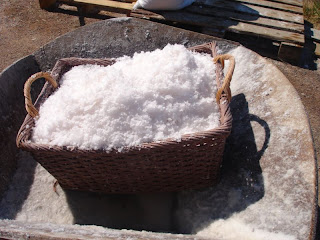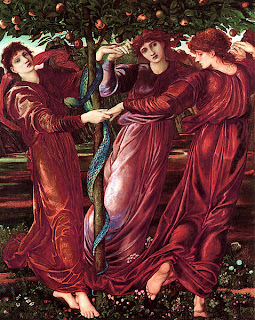Halloween in the 21st century is a party night of grinning Jack O'Lanterns and kids in costumes going out ‘Trick or
Treating’. It is now very much a
commercial event, with costumes, make-up, Halloween sweets and pumpkins being
sold. But here in Great Britain the origins of Halloween are much older and go
back to ancient times.
As the summer fades into a memory, the harvest has been
brought safely in and the nights grow colder our Celtic ancestors celebrated
the great feast of Samhain. For the
Celts, the year was divided into two seasons which were marked by two great
festivals. Beltane, celebrated on 1st
May ushered in the light season and Samhain marked the beginning of the dark
season on November 1st, the first day of winter. In ancient times, winter was a time of
stillness and waiting, a time where little new work could begin and survival
depended on the success of the summer harvests.
The animals would be brought down from the high pastures either to be
slaughtered and salted for winter use or to be sheltered in stables during the
bad weather, firewood would be chopped and stacked, and crops would be stored
and fruits preserved.
 |
| Old English Halloween Festivities |
Bonfires were traditionally lit on Samhain and sacrifices and
votive objects were thrown into the flames to ask for blessings, seek answers
to problems or plead for the healing of a sickness. These bonfires were lit, especially in
Scotland, as recently as the early part of the 20th century. People would dance around them, light torches
from them, and run around the fields so that parish boundaries would be
surrounded with a protective circle of light.
The bonfires are still lit in Britain at this time of year,
but now it is mainly on the 5th November to commemorate Guy Fawkes
and his Gunpowder Plot to blow up the English Parliament in 1605. The 5th November is known as
‘Bonfire Night’ and effigies of men known as ‘Guys’ are made and dressed in old
clothes, mainly by children, who then sit with their ‘Guy’ and ask passersby
for a ‘penny for the Guy’. The money is
traditionally used to buy fireworks and the Guy is placed on the bonfire as
it’s centrepiece before it is lit. The
fireworks are then set off while the bonfire is burning. There is also an old
rhyme that was chanted ‘Remember, remember the fifth of November, gunpowder
treason and plot, I see no reason why gunpowder treason should ever be
forgot...’ Poor Guy Fawkes paid a heavy
price for his crime as he was hung, drawn and quartered, which in those days
was the penalty for treason.
In Ottery St Mary in the county of Devon, there is a custom which dates back to 1688 where on 5th November men run through the streets of the town carrying flaming barrels of tar around on their shoulders until they can no longer bear the heat or the weight. Another man then takes over, and then another, until the barrel starts disintegrating and is left to burn itself out. Earlier in the proceedings there are smaller boy’s and women’s barrels and, as the evening goes on, the barrels get bigger and heavier. One of the most sought after souvenirs is one of the metal rings from a burnt out barrel. The custom started as a pagan cleansing ritual, designed to clear the town of evil spirits. An alternative theory is that the burning barrels were used in shops as a form of fumigation.
As Christianity came to Britain, the old customs were not
forgotten or given up. The churches of
this new religion were often built on sites that had been used for many centuries
for pagan ceremonies and worship. The new churches were given new names, new
religious rites were practiced but the old customs were continued. The feast of Samhain was changed to All
Saints Day or Hallowmas and the 2nd November was celebrated as All
Souls Day. All Saints Day honoured all of
the saints in heaven and All Souls Day was a day when prayers were said for all
the souls in Purgatory who were waiting to be forgiven. So the 31st October became known
as All Hallows, Hollantide in Wales and the Isle of Man or what we in modern
times call Halloween.
 |
| Jack o'Lantern |
In Cornwall the 31st October was known as Allantide
and was connected to a little known Cornish saint called St Allen or
Arlan. One of the customs of Allantide
was the giving of large, highly polished apples. They would be given to family members as
tokens of good luck and teenage girls would put them under their pillow in the
hope that they would dream of the person that they would marry one day. There was also a game played where pieces of
wood were put together to make a cross and then suspended with four candles
attached. The Allan apples would then be
hung under the cross and you would have to try and catch an apple in your
mouth. If you were clumsy or not quick
enough you would be punished by the hot wax from the candles dripping on you.
Indeed apples feature very heavily in Halloween customs and
dunking apples or apple bobbing is a widespread game that is played on this
night. Apples are placed in a large tub
of water and players have to get the apples out using only their teeth and with
their hands behind their backs. A
variation of this is where doughnuts or sticky cakes are suspended from a
string and eaten, again without the use of hands. Another method of divination
to find out who your future spouse was going to be was to peel an apple in one
strip, toss the peel behind your shoulder and see what letter of the alphabet
was formed when it landed. This letter
was believed to be the first letter of their name. It was also believed that if a single girl sat
in front of a mirror in a darkened room on Halloween the face of her future
husband would appear in the mirror; if she were due to die unwed the image of a
skull would appear instead.
A young girl could also guarantee dreaming of any future
romances by the way she arranged her shoes on this special night. If she put them in a ‘T’ shape and then
chanted ‘Hoping this night my true love to see, I place my shoes in the form of
a ‘T’. Apparently the ‘T’ was such a
powerful symbol because it resembled the shape of the hammer of the mighty
Norse god Thor. Another popular
divination game played at Halloween in order to discover the name of a future
husband was to put a line of hazelnuts across a hot grate. Each hazelnut was given the name of one of these
potential suitors and this rhyme was recited ‘If you love me pop and fly; if
you hate me, burn and die.’
The Ancient Celts also believed that on the eve of Samhain
the veil between the world of the living and the dead became thinner and that
the dead could wreak havoc among the living by causing sickness or ruining
crops. Masks and costumes were donned to
mimic the spirits and perhaps to pacify them.
In Scotland young men would blacken their faces and dress in white. The Celts would also put skeletons by their
windows to represent those who had died.
They also believed that the head was the most powerful part of the body
as it contained a person’s wisdom and spirit, so they would carve a lantern
from a swede or a turnip that represented a head and light these on Samhain Eve.
These came to known as Jack –o’-Lanterns after an Irish
legend where a man called Jack the Smith encountered the Devil when he was
drunk and managed to trap him up a tree.
To gain his release the Devil granted Jack’s request that his soul would
never be taken to Hell. When Jack came
to die a few years later, he was denied entry to Heaven because of his previous
drunken lifestyle and so went to the gates of Hell. Due to the promise that the Devil had made,
however, he was not admitted there either but was given a glowing ember to
carry with him in a turnip to light his way and brand him as a soul who
belonged in hell. It is believed that he
forever roams the night, not welcome in either the world of the living or the
world of the dead.
So as you see, there is a lot more to Halloween than a
horror film on the television and too much candy. It is a night that is steeped in tradition
and was a significant night in the spiritual beliefs of our ancient
ancestors. A night perhaps where it
would be better for you to curl up cosily under your duvet, for who knows who
or what you might encounter if you go wandering alone the swirling mists and darkness?
Old English Halloween Festivities Image Wikimedia Commons Public Domain
Jack o' Lantern Image Wikimedia Commons Public Domain
.jpg)

.JPG)

.JPG)

.JPG)




